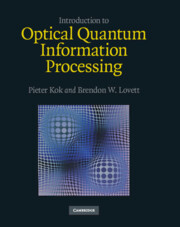Book contents
- Frontmatter
- Dedication
- Contents
- Preface
- Part I Quantum optics and quantum information
- Part II Quantum information in photons and atoms
- Part III Quantum information in many-body systems
- Appendix A Baker–Campbell–Haussdorff relations
- Appendix B The Knill–Laflamme–Milburn protocol
- Appendix C Cross–Kerr nonlinearities for single photons
- References
- Index
Preface
Published online by Cambridge University Press: 05 July 2014
- Frontmatter
- Dedication
- Contents
- Preface
- Part I Quantum optics and quantum information
- Part II Quantum information in photons and atoms
- Part III Quantum information in many-body systems
- Appendix A Baker–Campbell–Haussdorff relations
- Appendix B The Knill–Laflamme–Milburn protocol
- Appendix C Cross–Kerr nonlinearities for single photons
- References
- Index
Summary
The field of quantum information processing has reached a level of maturity, and spans such a wide variety of topics, that it merits further specialization. In this book, we consider quantum information processing with optical systems, including quantum communication, quantum computation, and quantum metrology. Optical systems are the obvious choice for quantum communication, since photons are excellent carriers of quantum information due to their relatively slow decoherence. Indeed, many aspects of quantum communication have been demonstrated to the extent that commercial products are now available. The importance of optical systems for quantum communication leads us to ask whether we can construct integrated systems for communication and computation in which all processing takes place in optical systems. Recent developments indicate that while full-scale quantum computing is still extremely challenging, optical systems are one of the most promising approaches to a fully functional quantum computer.
This book is aimed at beginning graduate students who are starting their research career in optical quantum information processing, and it can be used as a textbook for an advanced master's course. The reader is assumed to have a background knowledge in classical electrodynamics and quantum mechanics at the level of an undergraduate physics course. The nature of the topic requires familiarity with quantized fields, and since this is not always a core topic in undergraduate physics, we derive the quantum mechanical formulation of the free electromagnetic field from first principles. Similarly, we aim to present the topics in quantum information theory in a self-contained manner.
- Type
- Chapter
- Information
- Introduction to Optical Quantum Information Processing , pp. xi - xiiPublisher: Cambridge University PressPrint publication year: 2010



